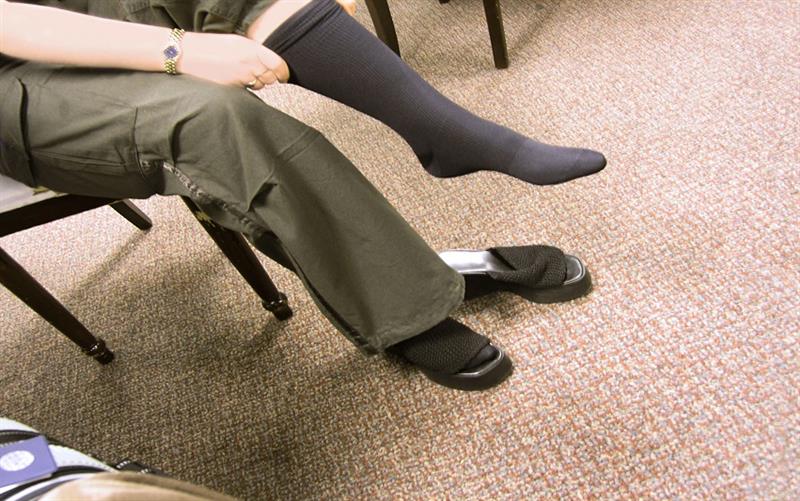
Investing in compression socks is a small but significant way to prioritize your comfort, health, and well-being during travel. Whether you're embarking on a long-haul flight, a road trip, or a sightseeing adventure, wearing compression socks can make a noticeable difference in how you feel throughout your journey.
Investing in compression socks for your next trip can be a game-changer, offering a multitude of benefits that contribute to a more comfortable and enjoyable travel experience. Here are some top reasons why compression socks should be a staple in your travel gear:
1. Improved Circulation:
Long periods of sitting during travel can lead to poor blood circulation, causing discomfort and even health issues like swelling and blood clots. Compression socks help promote better blood flow by gently squeezing your legs, which can reduce the risk of developing circulation problems. Improved circulation is one of the key benefits of wearing compression socks, especially during travel or extended periods of sitting or standing. Here's how compression socks help enhance circulation:
- Enhanced Blood Flow
- Reduced Risk of Blood Clots
- Prevention of Swelling
2. Reduced Swelling and Fatigue:
The gentle pressure applied by compression socks helps prevent fluid buildup in your legs, reducing swelling and the feeling of heaviness or fatigue. This is especially beneficial during long flights or extended periods of sitting, where swelling and discomfort are common. Compression socks are highly effective in reducing swelling and fatigue, especially during long periods of travel or prolonged sitting or standing. Here's how they help:
- Prevention of Fluid Retention
- Comfort During Travel
- Faster Recovery
3. Prevention of Deep Vein Thrombosis (DVT):
DVT is a serious condition where blood clots form in deep veins, often occurring in the legs during long periods of immobility, such as travel. Compression socks can significantly lower the risk of DVT by promoting healthy blood circulation and preventing blood from pooling in the legs. Compression socks play a crucial role in preventing Deep Vein Thrombosis (DVT), a serious condition where blood clots form in the deep veins of the legs. Here's how compression socks help in DVT prevention:
- Promotion of Healthy Blood Flow
- Prevention of Blood Pooling
- Support During Travel
4. Comfort and Support:
Compression socks provide support to your feet and legs, which can alleviate discomfort and achiness, particularly on long journeys. The cushioning and compression help reduce muscle fatigue, allowing you to arrive at your destination feeling more refreshed and ready to explore. Compression socks offer both comfort and support, making them a valuable addition to your travel essentials. Here's how they provide comfort and support during your journeys:
- Cushioning and Padding
- Prevention of Fatigue and Aches
- Support for Achy Feet and Legs
5. Temperature Regulation:
Some compression socks are designed with moisture-wicking and breathable materials, helping to regulate temperature and keep your feet dry and comfortable throughout your travels. This is particularly beneficial in hot or humid climates where feet can become sweaty and prone to discomfort. Compression socks contribute to temperature regulation through their choice of materials and design features. Here's how they help maintain optimal foot temperature:
- Breathable Fabrics
- Moisture-Wicking Properties
- Thermal Regulation
6. Minimized Risk of Varicose Veins:
Prolonged sitting or standing can contribute to the development of varicose veins, which are swollen and twisted veins that often appear on the legs. Compression socks help prevent varicose veins by improving blood circulation and reducing the pressure on vein walls, thus lowering the likelihood of vein damage. Compression socks can play a significant role in minimizing the risk of developing varicose veins, which are enlarged and twisted veins that commonly occur in the legs. Here's how compression socks help:
- Support for Veins
- Reduction of Swelling
- Comfort and Relief
7. Quick Recovery:
If you have an active itinerary planned for your trip, compression socks can aid in faster muscle recovery after a day of walking, hiking, or exploring. The compression helps reduce muscle soreness and fatigue, allowing you to make the most of your travel adventures without feeling worn out. Compression socks can aid in quick recovery after physical activity or long periods of travel. Here's how they contribute to faster recovery:
- Enhanced Circulation
- Reduction of Muscle Soreness
- Support for Injured Muscles
8. Prevention of Jet Lag:
Improved circulation facilitated by compression socks can help reduce the symptoms of jet lag. By promoting blood flow and reducing swelling in the legs, compression socks contribute to a smoother transition to your destination's time zone. While compression socks primarily focus on improving circulation and reducing the risk of conditions like deep vein thrombosis (DVT) during flights, they can indirectly contribute to the prevention of jet lag through several mechanisms:
- Enhanced Circulation
- Reduced Swelling and Discomfort
- Improved Rest During Flight
9. Enhanced Oxygen Delivery:
Improved blood circulation facilitated by compression socks aids in the delivery of oxygen to tissues, which can help combat the effects of reduced oxygen levels experienced during air travel. This can lead to increased energy levels and reduced feelings of lethargy upon arrival.
- Improved Rest During Flight
- Support for Circadian Rhythm
- Faster Recovery Upon Arrival
10. Reduced Risk of Leg Cramps:
Sitting in a cramped space for hours can increase the risk of leg cramps. Compression socks help prevent muscle fatigue and reduce the likelihood of cramping by providing support to the calf muscles. Compression socks can help reduce the risk of leg cramps, especially during long periods of inactivity such as flights. Here's how:
- Improved Circulation
- Prevention of Fluid Buildup
- Support for Muscles
- Reduced Muscle Vibration